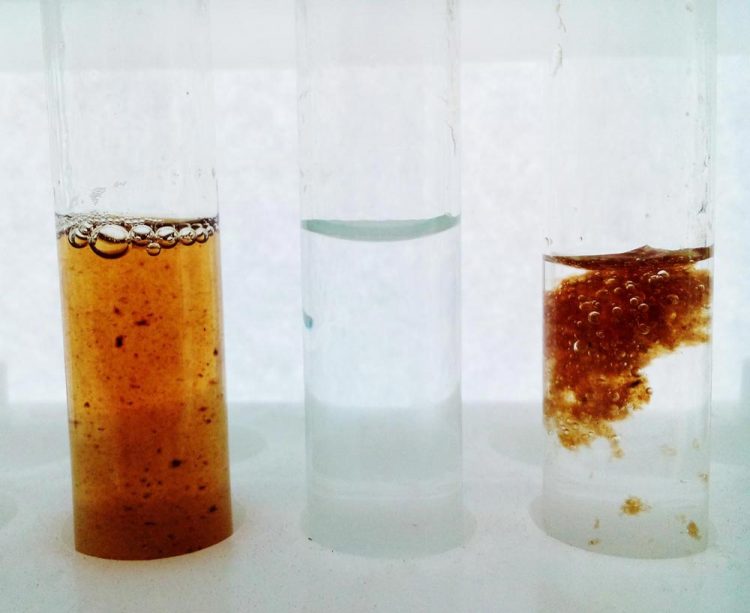How to purify water with graphene

1) Graphene oxide, added in water 2) Water after purification with graphene oxide 3) Graphene oxide 'flakes' with bacteria before extraction Credit: © NUST MISIS
Graphene and graphene oxide (a more stable version of the material in colloidal solutions) are carbon nanostructures that are extremely promising for Biomedicine. For example, it can be used for targeted drug delivery on graphene “scales” and for tumor imaging.
Another interesting property of graphene and graphene oxide is the ability to destroy bacterial cells, even without the additional use of antibiotic drugs.
Scientists from the National University of Science and Technology “MISIS” together with their colleagues from Derzhavin Tambov State University and Saratov Chernyshevsky State University have conducted an experiment, injecting graphene oxide into solutions (nutrient medium and the saline) containing E.coli.
Under the terms of the experiment, saline “simulated” water, and the nutrient medium simulated human body medium. The results showed that the graphene oxide along with the living and the destroyed bacteria form flakes inside the solutions.
The resulting mass can be easily extracted, making water almost completely free of bacteria. If the extracted mass is then treated with ultrasound, graphene can be separated and reused.
“As working solutions, we chose a nutrient medium for the cultivation of bacteria (it is to the natural habitat of bacteria), as well as ordinary saline, which is used for injections. As a tested bacterial culture, E. coli modified with a luminescent agent was used to facilitate visualization of the experiments, was used”, Aleksandr Gusev, one of the authors, Associate Professor of NUST MISIS Department of Functional Nanosystems and High-Temperature Materials, comments.
Graphene oxide was added to the nutrient solution in different concentrations – 0.0025 g/l, 0, 025 g/l, 0.25 g/l and 2.5 g/l. As it turned out, even at a minimum concentration of graphene oxide in saline (water), the observed antibacterial effect was significantly higher than in the nutrient medium (human body).
Scientists believe that this indicates not a mechanical, but a biochemical nature of the mechanism of action, that is, since there are far fewer nutrients in the saline solution, the bacteria moved more actively and was “captured” by the scales of graphene oxide more often.
According to the fluorescent test data, confirmed by laser confocal microscopy and scanning electron microscopy, at 2.5 g/l concentration of graphene oxide, the number of bacteria decreased several times compared to the control group and became close to zero.
While it is not yet known exactly how the further destruction of bacteria occurs, researchers believe that graphene oxide provokes the formation of free radicals that are harmful to bacteria.
According to scientists, if such a purification system is used for water, it will be possible to avoid additional chlorination. There are other advantages: decontamination with graphene oxide has a low cost, in addition, this technology is easy to scale to the format of large urban wastewater treatment plants.
Media Contact
More Information:
http://dx.doi.org/10.1016/j.msec.2019.01.093All latest news from the category: Life Sciences and Chemistry
Articles and reports from the Life Sciences and chemistry area deal with applied and basic research into modern biology, chemistry and human medicine.
Valuable information can be found on a range of life sciences fields including bacteriology, biochemistry, bionics, bioinformatics, biophysics, biotechnology, genetics, geobotany, human biology, marine biology, microbiology, molecular biology, cellular biology, zoology, bioinorganic chemistry, microchemistry and environmental chemistry.
Newest articles

Bringing bio-inspired robots to life
Nebraska researcher Eric Markvicka gets NSF CAREER Award to pursue manufacture of novel materials for soft robotics and stretchable electronics. Engineers are increasingly eager to develop robots that mimic the…

Bella moths use poison to attract mates
Scientists are closer to finding out how. Pyrrolizidine alkaloids are as bitter and toxic as they are hard to pronounce. They’re produced by several different types of plants and are…

AI tool creates ‘synthetic’ images of cells
…for enhanced microscopy analysis. Observing individual cells through microscopes can reveal a range of important cell biological phenomena that frequently play a role in human diseases, but the process of…





















